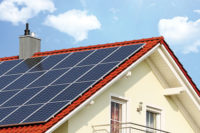
Roger Grochmal
What you witnessed, of course, depends a lot on when you were born. The replies we received span a respectable number of years.
“This is a very good question,” said Roger Grochmal, president of Atlas Air/ClimateCare, Oakville, Ont.; “One that after spending in excess of 35 years in the industry I feel somewhat qualified to answer. There have been all manner of changes, from the evolution of technology, especially improvements in efficiency; to a steady increase in regulation and government intervention in the industry; and the impact of consolidation at all levels of the industry.”

Aaron York
“The electronics used in the equipment has grown exponentially,” he said, “from wires to circuit boards. Thermostats are now minicomputers.” Equipment also uses more plastics and less metal, he observed. Manufacturers now also go through two model redesign changes a year. “It used to be one every two years. Simply put, the technology in the equipment has made it almost computer like.
“Any HVAC system over five years old is ancient by today’s standards.”
“In my opinion, the refrigerant changes have had the greatest impact on our industry, and it isn’t over yet,” said Aaron York Sr., from Aaron York’s Quality Air Conditioning & Heating Inc., Indianapolis.
HERMETICS
Looking further back, however, “The advent of hermetic and semi-hermetic compressors changed our industry forever,” York said. “But most of the techs today don’t even remember when there were no hermetics. You just might not either.” (Editor’s note: He was right, I didn’t.)There were many positives of hermetic compressors, he said:
• “They reduced the costs of compressors tremendously, and they became much smaller.
• “They eliminated refrigerant leaks that were always present at the crankshaft seals, many exposed gasketed surfaces, etc.
• “Without them our industry could have never grown like it has. The equipment would be much heavier, much bigger, much less dependable, and likely would not work with the refrigerants we have today.”
York continued: “The older compressors were cast iron and massive, as we had to have an open, reciprocating compressor driven by a large motor and compressor using sheaves and belts. When we did learn to drive the compressors via direct drives, we had motor-compressor shaft alignment issues that resulted in lots of refrigerant leaks, oil leaks, maintenance issues, and much less reliability.”
Hermetic compressors, he said, “took reliability to a much higher level. They also reduced maintenance costs. With the new units being so much smaller and lighter … air conditioning became practical for our homes. Had we not developed hermetics, almost everyone would still be sleeping and sweating all night with the windows open.
“Got to tell you lady; hermetic compressors changed the whole world - for the better.”

Jim Smith
MARKET FORCES
In the view of Jim Smith, of Product Management Services, Bremen, Ind., “I suggest that without competitive actions between the fossil fuel industry and the electric utilities, which occurred in the late 40s and 1950s, the most important compressor (and electric motor) changes would have taken many more years to happen.”After the end of World War II, he said, when the residential building boom started and “Johnny came marching home, the wars between the fossil fuel industry and the electric utilities heated up.” The fossil fuel side was “grabbing great shares of the new home heating business, and the electric utility gurus wanted their piece,” he said.
Thus the electric utilities began their research into heat pump technology, to get both the heating and cooling markets, Smith said. The creation of the reversing valve was a pivotal event. Defrosting the air-source heat pump was another hurdle, he said, and at first, “mechanical timers were used.”
HEAT PUMP GROWING PAINS
“After installing hundreds of air-source heat pumps in all locations around the USA, and having gone through the first winters,” Smith recalled, “the compressor failures started to happen in bunches. They were more situated in the Northern climates, while the milder heating needs of the Southern areas thrived.”Manufacturers sought solutions. “It didn’t take long for the hermetic compressor manufacturers to decide the problem was the extra load imposed by cold-weather heating,” Smith said. “The hermetic compressor technology just wasn’t there at that time. So, most all a/c manufacturers either got out of the air-source heat pump business, or restricted its use to the South, thus creating the heat pump myths that hang around even today.”
Before too long, Smith said, the compressor manufacturers figured out it was really an electric motor problem because most of the compressor failures had involved motor burnouts. General Electric in Fort Wayne, Ind., “supplied virtually most of the stators and rotors used in compressor motor manufacture, either directly or under a license agreement,” said Smith. GE gave the challenge over to its think tank in Schenectady, N.Y.
NEEDED IMPROVEMENTS
“You old timers out there might remember the early electric motors, with their stator wires covered with cotton insulation, and loosely tied (with thread) in a donut.… It didn’t take long for the cotton insulation to wear away, causing a dead short and an electrical burnout.” Other factors that were looked into included drive shaft lubrication and the reversing valve - the second most likely component to fail.GE’s engineers found that encasing the stator wires in plastic made them much more resistant to wearing. “Since that was good,” said Smith, “dipping the whole stator in plastic was even better. They also found that by increasing the motor speed from 1,650 rpm to 3,450 rpm, lubrication of the drive shaft bearings became easier because of the power of centrifugal force. Tougher steel was also added for the compressor valves.
“The R&D project cost GE more than $3 million, and changed the entire electric motor industry, which also changed the hermetic compressor industry,” Smith said. “The changes made by GE and the reversing valve makers forever changed the heat pump industry, and most persist today, some 40-plus years later, even into the Scroll era.”
The challenges met by the air-source heat pumps caused some people to look at the potential of a water-source heat pump, “to see if the tremendous variance in the outdoor air temps could be minimized by substituting water for the air. This, of course, became the boiler-tower systems, which later became the geothermal heat pump industry.”
Skipping ahead to the mid 2000s, “as a way to get the contractors to stop dwelling so much on the price, I started teaching them how to sell add-on heat pumps again. I called the course I was giving Hybrid 101,” to describe the combination of a fossil fuel furnace and an air-source heat pump. Carrier introduced it to their dealer network in 2007. “They called it ‘Hybrid Heat,’ and as they say, the rest is history.”

Ken Bodwell
LABOR AND COMPETITION
Some things never change - like the need for a qualified workforce. “What hasn’t changed is the need for quality-focused installers and service technicians,” said Ken Bodwell COO/CFO of Innovative Service Solutions, Orlando, Fla. “More so than any other trade, the HVACR technician must stay current with the technology and understand how the equipment is supposed to operate in conjunction with the system.“The service person today has evolved from a mechanic to a technician,” he continued. “While they still need the occasional socket set, they more often than not use meters and screwdrivers to identify and repair equipment. I think the manufacturers and industry associations have recognized this and offer excellent training for those companies and individuals willing to take advantage of the educational opportunities.”
“The one change that has impacted me the most is the way competition has changed,” said contractor Roger Grochmal. “In the old days, the industry was ‘managed’ by equipment suppliers and utilities. Suppliers performed the marketing around their brands, and the utilities managed the flow of work and acted as an interface between the consumer and the contractor to keep everybody ‘honest.’ ”
Nowadays, “The contractor manages the relationship with the homeowner, and the suppliers and utilities stick to their primary roles,” he continued. “What has really impacted things is the change in the face of competition. Today my competitors bear no resemblance to those of even 15 years ago. They are all major corporations, many publicly traded, who bring vast resources, marketing skills, and purchasing power to challenge the best of us. Retailers such as Home Depot, Sears, and Costco have powerful brands that draw customers to them as an adjunct to their other retail activities.”
Grochmal said he’s up to the challenge. “It’s what gets me out of bed every morning. I can move faster, with more creativity to provide superior service. Competition has made me a better contractor and businessman. I just hope enough of us want to continue to pitch the battle and give homeowners a real choice.”
In Bodwell’s view, “The many aspects of this industry are working closer together to achieve efficiency, productivity, and customer satisfaction, and that may be our most needed change.”

Ann Kahn
“Worker safety, once almost totally ignored, is considered an important management responsibility,” she continued.
“But the most significant change I have seen in the last 37 years is the professionalization of the contractor. Today’s HVAC contractor is far from that stereotyped guy who is one brick short of a load! For the most part, he/she is a very businesslike, knowledgeable, aggressive individual - necessary qualities to survive in today’s rapidly changing global economy!”
For more information, visit www.atlascare.ca, www.innovativeservicesolutions.com, www.kahnmechanical.com, www.superior-hvac.com, and www.yorksqualityair.com.
Sidebar: More Changes
According to Alan C. Veeck, CAFS, NCT, II , with the National Air Filtration Association, attitudes toward filtration have undergone major changes. “Originally designed to keep the equipment clean, this changed around 1985 after the realization that filters could protect the health of people in buildings by removing contaminants from the air. Early developments have lead to new filter media with even lower pressure drops, which allow for higher efficiencies, even in residential environments.”Stephen Francer, Francer Industries Inc., E. Weymouth, Mass., is a 51 year old who was born into the business. “My family has manufactured sheet metal ductwork, pipe, and fittings, and operated a manufacturers’ representative agency since 1949. One of the biggest changes I’ve seen in our industry over the past 30 years is the marriage of hydronics and HVAC.
“There was a time when ‘air guys’ would not touch a boiler, and ‘wet heads’ would not deal with ‘scorched air.’ Radiant heat systems, used in conjunction with air conditioning, has brought the two disciplines together. It has opened up market opportunities which previously did not exist.
Publication date:06/27/2011




